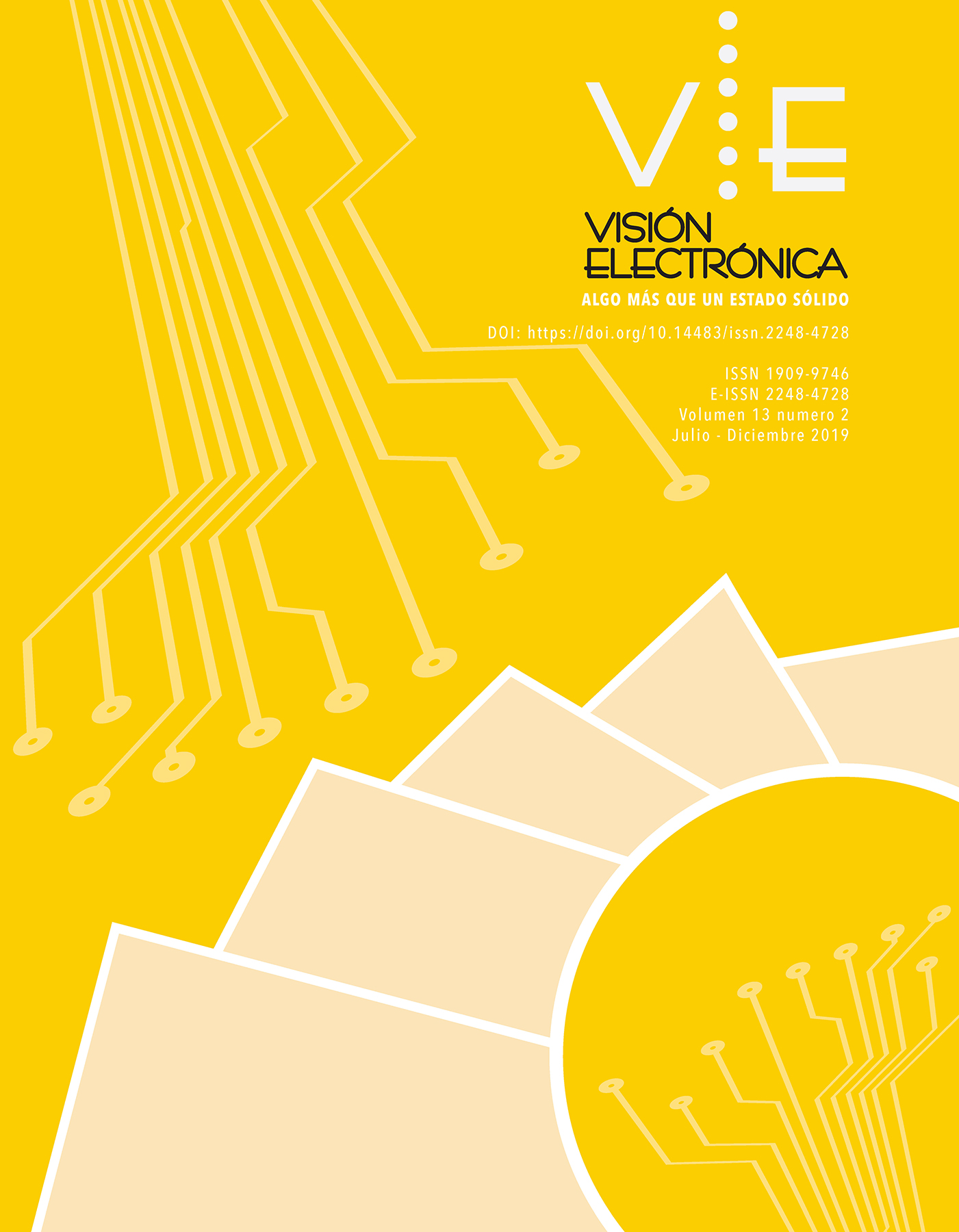DOI:
https://doi.org/10.14483/22484728.15181Publicado:
2019-07-30Número:
Vol. 13 Núm. 2 (2019)Sección:
Visión InvestigadoraDistribution system with wind penetration
Sistema de distribución con penetración eólica
Palabras clave:
Distributed Generation, Electrical Losses, Energy Efficiency, IEEE-13, Renewable Energies, Wind energy (en).Palabras clave:
Generación Distribuida, Pérdidas Eléctricas, Eficiencia Energética, IEEE-13, Energías Renovables, Energía Eólica (es).Descargas
Resumen (en)
This article presents the results of the analysis of the studies of the operation of a modified IEEE-13 distribution feeder, which was built to scale in the laboratory at Universidad del Norte. In this article, we show the cases of the operating regimes of the modified IEEE-13, before the different levels of wind energy penetration. The modified IEEE-13 distribution feeder was built taking into account that each of the scaled modules and their generator-load will work under the conditions of the Universidad del Norte laboratory. An experimental methodology was used to compare the results obtained in the actual scaled model with the results of the simulations in specialized programs. The conclusions of the article show the wind energy that can be injected into an electrical system with conventional power generation so that it can maintain its operation complying with the current regulatory framework.
Resumen (es)
En este artículo se presentan los resultados del análisis de los estudios de la operación de un alimentador de distribución IEEE-13 modificado, que fue construido a escala en el laboratorio en la Universidad del Norte. En este artículo, se muestran los casos de los regímenes de operación del IEEE-13 modificado, ante los diferentes niveles de penetración de energía eólica. Este alimentador de distribución IEEE-13 modificado se construyó teniendo en cuenta que cada uno de los módulos escalados y su generador-carga funcionarán en las condiciones particulares del laboratorio de la Universidad del Norte. Se utilizó una metodología experimental que, para la comparación de los resultados obtenidos en el modelo real escalado, con los resultados de las simulaciones en programas especializados. Se pudo definir la cantidad de energía eólica que se puede inyectar a un sistema eléctrico con generación de energía convencional, de modo que pueda mantener su funcionamiento, no sólo respetando las condiciones técnicas, sino también bajo el estricto cumplimiento de un marco regulatorio.
Referencias
J. Flórez, D. Tobón and G. Castillo, “¿Ha sido efectiva la promoción de soluciones energéticas en las zonas no interconectadas (ZNI) en Colombia?: un análisis de la estructura institucional”, Cuadernos de administración, vol. 22, no. 38, 2009, pp. 219–245.
Congreso de Colombia, “Ley 1715. Mayo 2014”, 2014. [Online]. Available at: http://www.secretariasenado.gov.co/senado/basedoc/ley_1715_2014.html
G. Pepermans, J. Driesen, D. Haeseldonckx, R. Belmans and W. D’haeseleer, “Distributed generation: Definition, benefits and issues”, Energy Policy, vol. 33, no. 6, 2005, pp. 787–798. https://doi.org/10.1016/j.enpol.2003.10.004
Y. M. Atwa and E. F. El-Saadany, “Optimal allocation of ESS in distribution systems with a high penetration of wind energy”, IEEE Trans. Power Syst., vol. 25, no. 4, 2010, pp. 1815–1822. https://doi.org/10.1109/TPWRS.2010.2045663
M. R. Baghayipour, A. Hajizadeh, A. Shahirinia and Z. Chen, “Dynamic placement analysis of wind power generation units in distribution power systems”, Energies, vol. 11, no. 9, 2018, pp. 1–16. https://doi.org/10.3390/en11092326
K. Maki, “Effect of wind power based distributed generation on protection of distribution network”, Eighth IEEE International Conference on Developments in Power System Protection, 2005, pp. 327–330. https://doi.org/10.1049/cp:20040129
T. R. Ayodele, A. Jimoh, J. L. Munda and A. J. Tehile, “Challenges of Grid Integration of Wind Power on Power System Grid Integrity: A Review”, Int. J. Renew. Energy Res., vol. 2, no. 4, 2012, pp. 618–626.
V. Mendez, J. Rivier and T. Gomez, “Assessment of Energy Distribution Losses for Increasing Penetration of Distributed Generation”, IEEE Trans. Power Syst., vol. 21, no. 2, 2006, pp. 533–540. https://doi.org/10.1109/TPWRS.2006.873115
H. Ahmadi and H. Ghasemi, “Maximum penetration level of wind generation considering power system security limits”, IET Gener. Transm. Distrib., vol. 6, no. 11, 2012, pp. 1164–1170.
S. N. Liew and G. Strbac, “Maximising penetration of wind generation in existing distribution networks”, IEEE Proc. - Gener. Transm. Distrib., vol. 149, no. 3, 2002, pp. 256-262.
O. P. Mahela, P. Prajapati and S. Ali, “Investigation of Power Quality Events in Distribution Network with Wind Energy Penetration”, IEEE Int. Students’ Conf. Electr. Electron. Comput. Sci. SCEECS, 2018, pp. 1–5. https://doi.org/10.1109/SCEECS.2018.8546945
R. H. A. Zubo, G. Mokryani and R. Abd-Alhameed, “Optimal operation of distribution networks with high penetration of wind and solar power within a joint active and reactive distribution market environment”, Appl. Energy, vol. 220, 2018, pp. 713–722. https://doi.org/10.1016/j.apenergy.2018.02.016
Y. Chang et al., “Risk Assessment of Generation and Transmission Systems Considering Wind Power Penetration”, Int. Conf. Power Syst. Technol. POWERCON, 2018, pp. 1169–1176. https://doi.org/10.1109/POWERCON.2018.8601737
P. De la Hoz, A. Silva, R. Castillo-sierra, I. Oliveros, M. Pardo and E. Jimenez, “UniGRID: Photovoltaic Study Case for the Universidad del Norte Renewable Energies”, 15th International Conference on Electrical Engineering, Computing Science and Automatic Control (CCE), 2018, pp. 1–6. https://doi.org/10.1109/ICEEE.2018.8533985
ENAIR, “Aerogenerador ENAIR E30 PRO Ficha Técnica” [Online]. Available at: https://www.enair.es/es/Aerogeneradores/E30PRO
IEC, “IEC International Standard 61400-1”, 2008, pp. 1–9. [Online]. Available at: https://webstore.iec.ch/preview/info_iec61400-1%7Bed3.0%7Den.pdf
J. Conto, “Grid challenges on high penetration levels of wind power”, IEEE Power Energy Soc. Gen. Meet., 2012, pp. 1–3. https://doi.org/10.1109/PESGM.2012.6344717
Comisión de Regulación de Energía y Gas - CREG, “Resolución No. 024 de 2005”, 2005. [Online]. Available at: http://www.creg.gov.co/html/Ncompila/htdocs/Documentos/Energia/docs/resolucion_creg_0024_2005.htm.
Empresa Electrificadora de Santander ESSA, “Norma Técnica ESSA, ”Normas para cálculo y diseño de sistemas de distribución”, 2004. [Online]. Available at: https://www.essa.com.co/site/Portals/14/Docs/Norma%20tecnica/Norma%20T%C3%A9cnica%20ESSA.pdf


.png)




.jpg)





